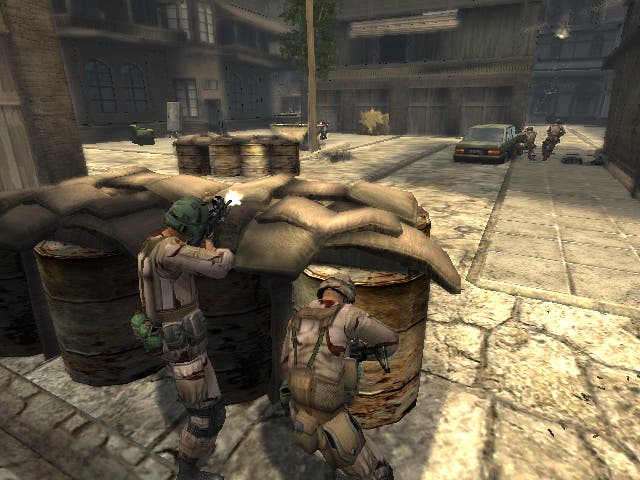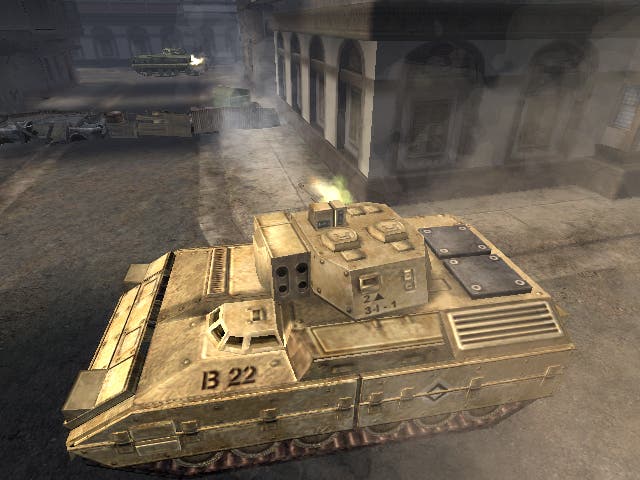Full Spectrum Warrior: Ten Hammers
Hammertime!
Although you could argue that Pandemic's first "Spectrum Warrior" title didn't exactly leave us "Full", you'd be hard pressed to convince me that it didn't give us something interesting to chew on. With the sequel, Ten Hammers, the developer has reacted to criticism and refined a number of elements that ought to make for a more enjoyable game - helped no doubt by its newfound distance from the core specification demanded by the US Army for the original training tool upon which FSW was based.
Set in the same fictional Middle-Eastern country (Krablakistan or something), but spread out over new areas including a swamp, Ten Hammers seems to be striking out in various new directions - partly logical extensions of what we already had, and partly some quite discerning design decisions gearing the game toward a more dynamic, er, dynamic. But I'll get onto that bit later.
The original game (to re-cap it in less space than it normally takes me to describe camera positions) had you switching your focus between fire teams and directing their movement between cover points, watching out for terrorists (sorry, insurgents) and securing objectives and UN mandates [stop it -Ed], without ever directly controlling units in the manner of a traditional third-person action game. It was more of a strategy game in that regard, mixing turn-based and real-time elements commendably.
Key control changes all sound off convincingly. These include the ability to control one team and order another to do things without switching control over to them. For example, you might have control of your primary fire team, but still be able to direct a secondary team to hide behind a particular bit of wall that you can see from your position but they can't from theirs. You can also order them to do things like attack or suppress enemies, while all the usual considerations like ammo reserves and susceptibility to attack from other directions still apply.

Your fire teams can now move with guns at the ready, firing when they reach their allotted position, and it's also possible to assume a degree of direct control over their gunnery, selecting one unit and using the analogue stick (or mouse) to train your sights on an enemy position. This is obviously quite an alarming change in the context of a game that generally lets your troops do the aiming and makes you obey the ruleset, and is likely to prove contentious, but Pandemic reckons that this is offset by the extreme level of vulnerability that comes with standing up to aim manually.
You can also split your four-man teams up, sending a pair into a building to snipe. And yes, that does mean you can move up and down this time too, giving the game a much-needed vertical element. Whether this will over-complicate proceedings or not is something I couldn't possibly guestimate at this stage, but I'd imagine that this does not mean you'll be able to occupy any building you like and hit every roof, nick choppers and fly around picking up hookers then dumping them on the street. (They'll probably save that for Full Spectrum Vietnam, which is a frankly horrifying concept that I shouldn't really joke about just in case.) In other words, hilly levels may not be something we see this time either.

As well as your fire teams, this time you'll also be able to send out scouts, who can report on gunfire and the like in advanced positions, and assume control of vehicles in the shape of tanks and Humvees. These operate like an extra team - you can tell them to train their gun barrels expectantly on a bit of empty street as they roll past, and so on, but obviously they don't have to sidle up against walls. They do have to keep a relatively low profile though, because rocket-propelled grenades are prevalent amongst the bad guys.
Finally, a couple of typical sequel additions. Competitive multiplayer is finally in, for up to eight players. US versus insurgents. Lord. I'm not touching that one with a forty-foot statue of a toppled despot. The other big change is the intelligence level of your computer-controlled adversaries. They will now hide when they see you, dodge grenades, respawn into areas you're backtracking through, and so on. Which, coupled with the direct aiming and 3D element leads us inexorably to the big question: given that FSW was widely revered for being both a tactical military simulation and the closest we've come to a proper-console, Advance Wars-style mixture of puzzle and strategy, will Ten Hammers and its new ideas divide, or will it conquer?
Full Spectrum Warrior: Ten Hammers is due out in Q1 2006 on PS2, Xbox and PC.

